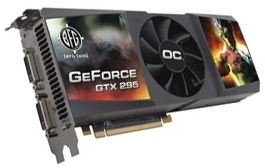The Best nVidia GeForce Video Cards for Intel Core i7 Processors
Nothing pushes a computer’s processing power like PC games. In the quest for higher frame rates and smoother video, nothing increases your computer’s gaming power like a good combination of processor and video card. If you are thinking of investing in an Intel Core i7 and an nVidia GeForce processor to form the basis of your gaming platform, consider the video cards in this article to experience all that the Core i7 has to offer in gaming.
#1 – BFG nVidia GeForce GTX 295 Overclocked – 1792MB GDDR3, PCI Express 2.0
At the top of the list is a video card the boasts one of the latest graphics chips from nVidia’s impressive line of high-end video cards. BFG offers the nVidia GeForce GTX 295 graphics processor in an overclocked version that puts most other gaming cards to shame.
The impressive 1792MB GDDR3 memory is one of the key components that makes this card sit on the top of the list of video cards to consider pairing with an Intel Core i7 CPU. With an 896-bit memory interface, a core clock of 601MHz, and a memory clock of 2052MHz, everything about the GTX 295 overclocked screams power.
The price of this fabulous video card, however, is not for the faint of heart. With a street price of US$519.99, it’s not the most expensive graphics card on the market, but it still costs more than some whole computers.
#2 – EVGA nVidia GeForce GTX 285 – 2048MB GDDR3, PCI Express 2.0
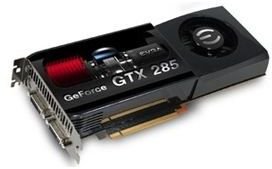
Just one-step down from the GTX 295 is the nVidia GeForce GTX 285 from EVGA. With 2 Gigabytes (2048MB) of RAM, this card can hold a tremendous amount of data leaving more processor power to push a game’s graphics to your monitor.
The power of the GTX 285 comes from its 512-bit memory interface, a core clock of 648MHz, and a memory clock of 2480MHz. Notice that the core clock and memory clock of the GTX 285 is actually higher than the GTX 295 discussed above. This makes this card a close second to the GTX 295 with a more reasonable price.
With a street price of US$429.99, the EVGA GeForce GTX 285 is a bit more affordable than the GTX 295 above while sacrificing little in terms of raw graphics power when coupled with an Intel Core i7 processor.
#3 – EVGA nVidia GeForce 275 Superclocked – 896MB GDDR3, PCI Express 2.0
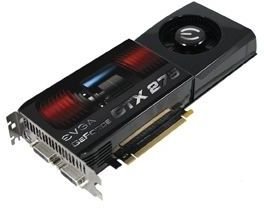
In the middle of the list, we have the nVidia GeForce 275 Superclocked from EVGA. EVGA is known for producing high-quality cards that tend to undercut the competition on price. The 896MB of GDDR3 RAM is respectable although not as much as some of the higher end cards on the market.
At 448-bit, the memory interface on the GeForce 275 is a bit less than some other high-end cards. Luckily, the 275 boasts a core clock of 648MHz and a memory clock of 2376MHz, which keeps in on par with the 285 and the 295 discussed above. As third on the list of cards that work well with the Core i7 CPU, the price of the EVGA GeForce 275 Superclocked is much more reasonable that the previous two graphics cards.
With a street price of US$269.99, this video card offers a balance between price and power and probably represents the best value on this list. Not too expensive and not too underpowered, the GeFore 275 is one of the best deals on the graphics card market.
#4 – BFG nVidia GeForce 260 OCX Maxcore – 896MB GDDR3, PCI Express 2.0
Near the bottom of the list of cards to consider with the Intel Core i7 processor, the BFG nVidia GeForce 260 OCX Maxcore is an excellent choice for the budget-minded gamer. The 896MB of GDDR3 RAM is still a respectable amount of memory and the core features of the card make it a good buy.
Like the GeForce 275 above, the GeForce 260 also sports a 448-bit memory interface coupled with a 655MHz core clock and a 2250MHz memory clock. Not one of the more powerful graphics cards on the market, the 260 still chugs along quite well when coupled with a Core i7 processor. If you are a mainstream gamer, this card may be a bit too slow for you if you prefer to play your games on the highest graphics settings. If you are a casual gamer, the BFG GeForce 260 represents a solid value and good choice for the Core i7.
With a street price of US$199.99, this sub-$200 card is adequate if you are a gamer on a budget or just don’t play the kinds of games that boast eye-popping graphics.
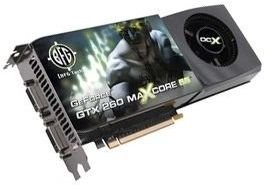
#5 – XFX nVidia GeForce 250 Core Edition – 1024MB DDR3, PCI Express 2.0
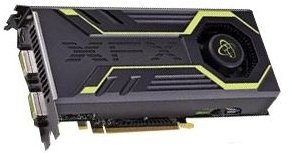
At the bottom of this list, we have the nVidia GeForce 250 Core Edition from XFX. Like EVGA, XFX is known for producing quality cards at good prices. With a respectful 1024MB of DDR3 RAM, this card has enough memory to see you through your gaming endeavors for the next couple of years.
The GeForce 250 sports a 256-bit interface, a 738MHz core clock, and a 2200MHz memory clock. Seemingly comparable to the cards above, this graphics card just doesn’t have the core processing power to place it nearer the top of the list. Still, the GeForce 250 is a contender for a gamer who needs to stretch every dollar. The price and power of the GeForce 250 from XFX places this card at the bottom of the high-end range but still within the threshold of being a good pairing with the Intel Core i7 CPU
With a street price of just US$154.99, the GeForce 250 is a bargain for your Core i7-based gaming platform. Just don’t expect to play your games at the highest settings, especially when playing multi-player games online.
Conclusion
The cards discussed above represent a wide-range of graphics card options for your Core i7 computer. At the high end, we see that power comes with a hefty price tag. However, at the mid-range and low-end range, we see that the graphics card for you Core i7 computer need not cost you an arm and a leg.
The key to buying a video card for a Core i7 processor is to assess your gaming needs and buy accordingly. Buy too much and you end up wasting money that you could have used on other computer components or put back into your pocket. Buy too little and you waste even more money upgrading your video card before you should have had to.
